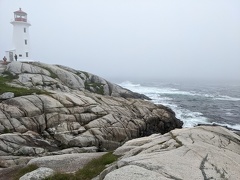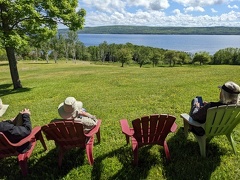
Peggy's Cove NS
In August 2022, we completed a motorcycle ride around the perimeter of the USA and Canada. The trip included many roads, museums and destinations that have been on my “motorcycle must do” list for many years. In particular,
- I’ve always wanted to ride to Key West (so we did),
- Three states had been missing from my "ridden there" list—Alabama, Mississippi, and Louisiana (not any more),
- Debbie has never been to the Americade motorcycle rally (been there, done that),
- and I wanted to return to the Canadian Maritime since visiting on my Suzuki 750 in the mid-1980s (did, better than ever).
The trip statistics:
- 17,656 miles / 28,414 kilometers (16,982 route miles excluding local travel)
- 130 nights on the road, mostly in hotels
- 23 US States and 9 Canadian Provinces visited
A few commonly asked “bests”:
- Best non-motor vehicle museum: Manitoba Museum
 in Winnipeg
in Winnipeg - Best motor vehicle museum: Barber Vintage Motorsports Museum

- Best food: Quebec poutine
 (french fries and cheese curds topped with brown gravy)
(french fries and cheese curds topped with brown gravy) - Best fast food: A&W (eat-in food served on real plates with metal silverware and a glass frosty mug. And poutine is on the menu!)
- Best hotel surprise: Patriots Inn in Williamsburg VA (An "apartment" with kitchen, living room, bedroom, and bathroom for just over $100/night.)
- Best motorcycle road: Cherohala Skyway in NC and TN
Here are some pictures from the trip and a map of the route with overnight stops.
Some thoughts and observations about six weeks living in Canada.
History
The territory that is today eastern Canada was settled mostly by the French and became their colony for many years.
An important part of eastern Canada is Acadia, which was one of the 5 regions of New France. Acadia was located in what is now Eastern Canada's Maritime provinces and parts of Quebec along with present-day Maine to the Kennebec River. Today, in many places, people in this area still display the Acadian flag, along with the national and provincial flags. The British, together with New England legislators and militia, carried out the Great Expulsion of the Acadians between 1755 and 1764. Later many returned to this area of eastern Canada. The French ceded Canad in the 1763 as part of the Treaty of Paris. Today's residence take great pride in their French heritage.
So the culture is a blend between French and English. The country has both as official languages so most signs are in both languages, but this varies by province with Quebec leading signs with French and often not offering English, versus British Columbia leading with English and rarely using French other than in some official signage. In the eastern provinces there were many advertisements encouraging residences to take courses in French to complete their understanding of the language and culture. The history between the French and English is complex and we learned much about the subject through visiting many museums. Now I find it is much easier to understand the present day issues knowing the history.
Relations with the native people (known throughout Canada as "First Nations" people) from the earliest times focused on cooperation. Unlike in the USA, there are few historical examples of attempts to eliminate the natives during colonization. Instead I found many historical examples where the focus was on co-existence and cooperation.
Case in point, the Hudson Bay and North-West Companies were formed during colonial times to provide furs to England for hats and other clothing, which were very popular and lucrative at the time. These companies partnered with the First Nation peoples, who were experienced trappers. A business was formed around the natives doing the trapping then trading pelts for hard goods (e.g., pots, knives, cotton cloth, etc.). Trading forts for this purpose were built by each company, some of which are museums today. Later treaties were struck with the First Nations people that are still in place today.
The North-West Mounted Police, which later became today's RCMP, was established to avoid the US Army entering Canada in the late 1800's to attack (destroy) the natives.
Now, native perspective is provided at every museum with signs in the native language along with French and English. Sections of each museum describe the First Nations history in the area. Most prominent buildings have signs acknowledging that the building is built on a specific tribe's land.
Overall, Canada's history leans much more toward a cooperative, or at least co-existence, approach with the native tribes.
Some current differences from the USA

Immigration is desirable and common in Canada. Over a decade back the country recognized their growing issue with population aging. They will need many younger (working age) people to immigrate to sustain the economy. So the immigration laws reflect this situation by making it much easier than in the USA for workers to come to the country long-term.
There are programs for immigrants to come and fill jobs leading to citizenship. These programs encourage migration to areas that need workers. They include cultural and language training with testing at key points. We saw signage and watched TV public service promotions that welcomed foreigners and explaining how to function in the society. We met many young people taking advantage of the programs from countries around the world. All were working and learning with an intent to become Canadian citizens.
It was common to find areas in major cities with signage in languages other than English or French. These areas reflect the volume of immigration.
Sunlight, a long popular clothing detergent brand, has an advertisement on television focused on an immigrant family and the “feel good” story around find a job and fitting in to the country's population.
We did not detect animosity from multi-generation Canadians towards the newer immigrants.
Overall, while the USA is often referred to as the cultural "melting pot", it felt like Canada was much more representative of such.
Crime and conflict seemed much lower in Canada. Shooting incidents are very rare. The 2020 mass shooting in Nova Scotia where 22 were killed really sticks out because it is so rare there. This was the worst in the county’s history.
Drivers largely travel very near the speed limit. Commonly, on a road with a 100 kph limit traffic will be traveling around 105 to 110 kph. The exception was outside the city of Quebec where cars were commonly traveling 120+. We saw very limited speed enforcement.
The entire country was clean. No trash alongside roads or on sidewalks. Recycling was everywhere. Talking with folks, we detected a shared sense of taking care of each other and the place they live. Generally, they have a stronger sense of doing what is good for the group rather than the individual.
It was fantastic to visit Canada. We return from the experience with numerous fond memories. We met many friendly people—some are new friends. There is so much natural beauty. I'd strongly consider living in Canada.

